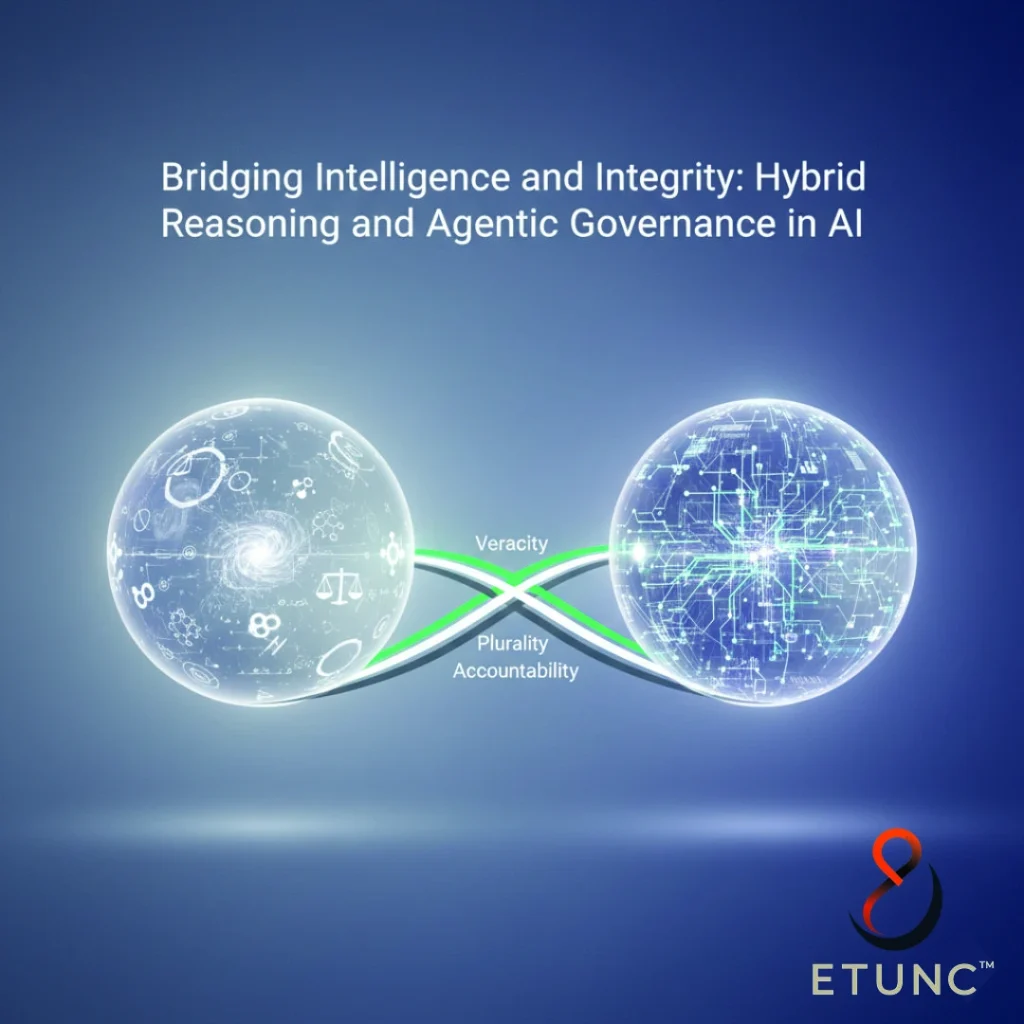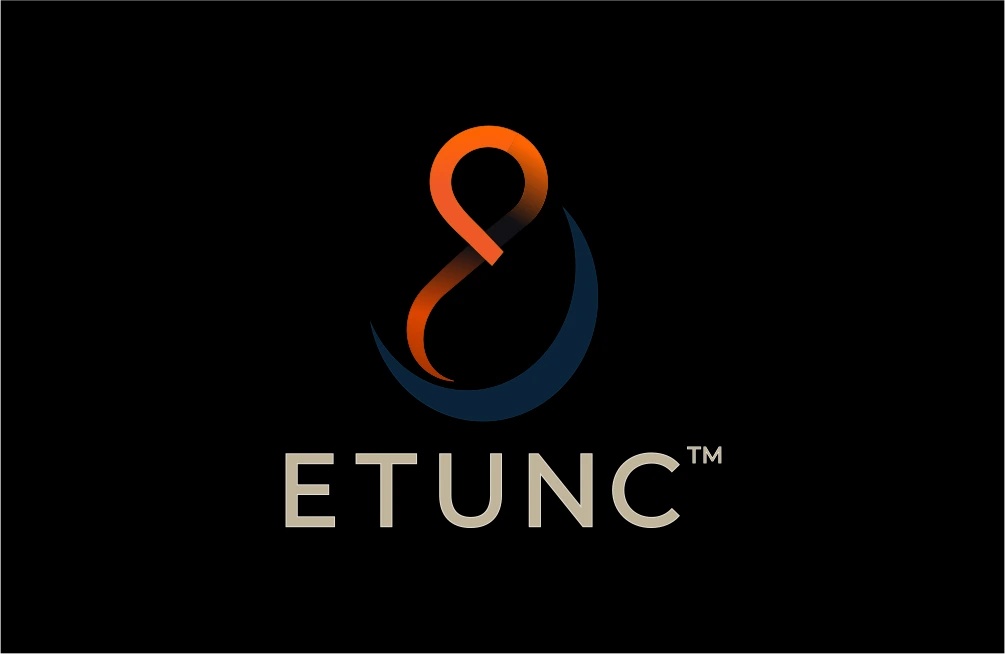
Introduction
Each week, the research world offers glimpses into the moral architecture of intelligence. Between October 20 and November 3 2025, five significant studies charted a decisive shift: AI research is moving beyond mere competence toward compositional reasoning and ethical orchestration. From neuro-symbolic taxonomies to provable governance models, the field is aligning itself—often unknowingly—with ETUNC’s founding principle: that judgment, not computation, defines true intelligence.
This Insight examines these developments through the ETUNC Compass of Veracity, Plurality, and Accountability (VPA), interpreting how academic rigor is converging with ETUNC’s architectural roadmap toward Judgment-Quality AI.
Section 1 — Core Discovery: A Convergence of Integrity and Intelligence
1. Advancing Symbolic Integration in LLMs — Rani et al., 2025 (ArXiv Oct 24)
Rani and colleagues dissect the uneasy marriage between neural fluency and symbolic logic. Their “post-NeSy” taxonomy formalizes how reasoning systems can layer symbolic integrity atop stochastic language generation.
Relevance to ETUNC: This paper serves as a design charter for ETUNC’s Guardian layer, validating that truth in large models demands explicit symbolic scaffolding.
VPA Mapping: Veracity → symbolic auditability · Plurality → representation diversity · Accountability → rule-traceable outputs.
2. Fetch.ai: An Architecture for Modern Multi-Agent Systems — Wooldridge et al., 2025 (ArXiv Oct 21)
Fetch.ai extends classical multi-agent theory into decentralized markets of identity, negotiation, and transaction.
Relevance to ETUNC: It embodies ETUNC’s Envoy vision—agents that coordinate ethically under transparent, distributed ledgers.
VPA Mapping: Veracity → verifiable inter-agent transactions · Plurality → heterogeneous role negotiation · Accountability → immutable audit records.
3. A4FN: Agentic AI for Autonomous Flying Networks — Coelho et al., 2025 (ArXiv Oct 4)
A4FN divides cognition between perception and decision/action agents operating across distributed aerial systems.
Relevance to ETUNC: A tangible model for distributed cognition, illustrating how perception-reason-act cycles scale through cooperative autonomy.
VPA Mapping: Veracity → context-sensitive adaptation · Plurality → specialized agent collaboration · Accountability → mission-trace and safety logs.
4. LLM-Augmented Symbolic NLU System — (ArXiv Oct 2025)
Combining LLMs with symbolic NLU validation, this hybrid improves reliability in fact extraction and reasoning tasks.
Relevance to ETUNC: Directly parallels the Guardian’s verification loop — neural intuition checked by symbolic law.
VPA Mapping: Veracity → truth filtering · Plurality → semantic layer diversity · Accountability → verification chain.
5. Interpretable Visual Reasoning through Human Feedback — IRJET Oct 2025
Integrating human rationales and explanation scoring, this system raises faithfulness (+19 %) and user comprehension (+27 %) in vision-language reasoning.
Relevance to ETUNC: Demonstrates how human feedback loops operationalize judgment—an essential component of ETUNC’s Resonator.
VPA Mapping: Veracity → explanation faithfulness · Plurality → human + machine reasoning · Accountability → explanation metrics.
Section 2 — Integration with ETUNC Architecture
Across these papers, the field converges toward ETUNC’s tripartite system:
- Guardian (Layer of Truth): Implements symbolic verification, policy-as-code, and neural-symbolic coupling to ensure interpretive fidelity.
- Envoy (Layer of Plurality): Manages decentralized agent negotiation, ensuring balanced multi-stakeholder decision flows.
- Resonator (Layer of Accountability): Captures reflection, feedback, and adaptive correction through transparent audit traces and human collaboration.
Collectively, they form the Compass Inside—a cognitive geometry ensuring that every output passes through ethical triangulation. Each research contribution reinforces one edge of that compass, confirming ETUNC’s structural foresight.
Section 3 — Ethical and Societal Context
The emergent paradigm of hybrid and agentic systems forces a reconsideration of how AI earns trust. The academic community is beginning to quantify what ETUNC framed philosophically: truth is not static, but systemically maintained.
Ethical AI now demands architectural accountability rather than retrospective regulation. Multi-agent coordination implies shared moral load; symbolic overlays make reasoning inspectable; human feedback reintroduces empathy into code.
In this ethical topology, Veracity becomes measurable, Plurality becomes procedural, and Accountability becomes constitutional. The consequence is profound: governance is no longer an external imposition but an intrinsic property of cognition.
Section 4 — Thematic Synthesis / Trends
| Emerging Theme | Academic Pulse | ETUNC Interpretation |
|---|---|---|
| Neuro-Symbolic Coupling | Transition from ad-hoc hybrids to formal integration taxonomies. | Validates Guardian’s design for rule-anchored truth. |
| Decentralized Agentic Systems | Multi-agent orchestration with on-chain identity and negotiation. | Aligns with Envoy’s distributed Cognition Layer. |
| Human-on-the-Loop Feedback | Quantified improvement in interpretability and user trust. | Resonator’s feedback and EX-score modules. |
| Governance by Design | Ethical scaffolds integrated within architectures, not policies. | Embodied Accountability via Compass VPA triangulation. |
| Transparent Learning Pipelines | Traceable reasoning chains for audit and oversight. | Foundational to ETUNC’s Judgment-Quality standard. |
Section 5 — Suggested Resource Links
Insights (ETUNC Internal):
- Bridging the Gap: How Influencer Voices Echo Academic Ethics in AI Today
- From Agents to Accountability: ETUNC’s Compass in Action
Academic (External):
- Rani et al., Advancing Symbolic Integration in LLMs (ArXiv 2510.21425)
- Wooldridge et al., Fetch.ai: Architecture for Modern Multi-Agent Systems (ArXiv 2510.18560)
- Coelho et al., A4FN: Agentic AI Architecture for Autonomous Flying Networks (ArXiv 2510.11012)
- LLM-Augmented Symbolic NLU System (ArXiv Oct 2025)
- Interpretable Visual Reasoning through Human Feedback (IRJET Oct 2025)
Conclusion
The research frontier is finally echoing what ETUNC has articulated since inception: intelligence without integrity collapses under its own entropy. The fusion of symbolic rigor, decentralized cognition, and ethical transparency marks the transition from artificial intelligence to architected intelligence.
As the world races toward ever-larger models, ETUNC’s compass remains steady—anchoring innovation in Veracity, Plurality, and Accountability. The question is no longer whether AI can reason, but whether it can be trusted to judge.
Call to Collaboration
ETUNC invites partnerships with research institutions, enterprises, and governance bodies advancing hybrid reasoning, agentic orchestration, or AI accountability frameworks. Together, we can establish the standards and open architectures for Judgment-Quality AI.
Collaborate → ETUNC.ai/Contact
Integrity is the new intelligence.
ETUNC.ai — Veracity · Plurality · Accountability
